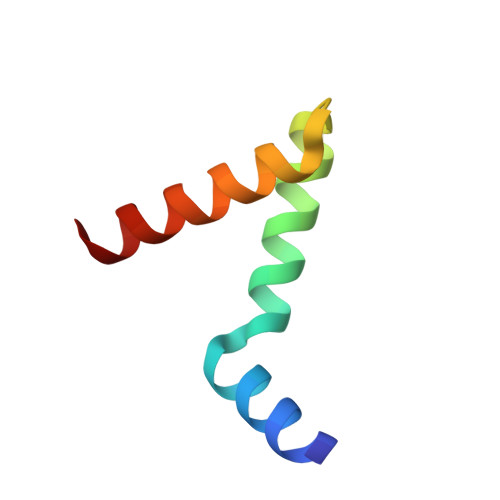Structure of smAKAP and its regulation by PKA-mediated phosphorylation.
Burgers, P.P., Bruystens, J., Burnley, R.J., Nikolaev, V.O., Keshwani, M., Wu, J., Janssen, B.J., Taylor, S.S., Heck, A.J., Scholten, A.(2016) FEBS J 283: 2132-2148
- PubMed: 27028580
- DOI: https://doi.org/10.1111/febs.13726
- Primary Citation of Related Structures:
5HVZ - PubMed Abstract:
The A-kinase anchoring protein (AKAP) smAKAP has three extraordinary features; it is very small, it is anchored directly to membranes by acyl motifs, and it interacts almost exclusively with the type I regulatory subunits (RI) of cAMP-dependent kinase (PKA). Here, we determined the crystal structure of smAKAP's A-kinase binding domain (smAKAP-AKB) in complex with the dimerization/docking (D/D) domain of RIα which reveals an extended hydrophobic interface with unique interaction pockets that drive smAKAP's high specificity for RI subunits. We also identify a conserved PKA phosphorylation site at Ser66 in the AKB domain which we predict would cause steric clashes and disrupt binding. This correlates with in vivo colocalization and fluorescence polarization studies, where Ser66 AKB phosphorylation ablates RI binding. Hydrogen/deuterium exchange studies confirm that the AKB helix is accessible and dynamic. Furthermore, full-length smAKAP as well as the unbound AKB is predicted to contain a break at the phosphorylation site, and circular dichroism measurements confirm that the AKB domain loses its helicity following phosphorylation. As the active site of PKA's catalytic subunit does not accommodate α-helices, we predict that the inherent flexibility of the AKB domain enables its phosphorylation by PKA. This represents a novel mechanism, whereby activation of anchored PKA can terminate its binding to smAKAP affecting the regulation of localized cAMP signaling events. Structural data are available in the PDB under accession number 5HVZ.
Organizational Affiliation:
Biomolecular Mass Spectrometry and Proteomics, Bijvoet Center for Biomolecular Research and Utrecht Institute for Pharmaceutical Sciences, Utrecht University, The Netherlands.















